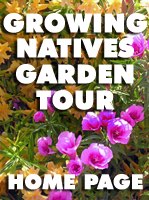
|
Label making ideas for the Garden
|
|
Home
Frequently Asked Questions
2010 Tour Gardens
GNGT Store
2010 Tour Flyer
Prior Year Tours:
2009 Tour Report
2008 Tour Report
2009 Tour Gardens
2008 Tour Gardens
2007 Tour Gardens
2006 Tour Gardens
Gardening With Natives Forum
Plant Labeling Ideas
California Native Plant Professionals
Pressroom
Invasive Plants of Concern
Other Native Garden Tours:
SAN FRANCISCO:
Spring Garden Tour
April 5, 2009
EAST BAY:
Bringing Back the Natives Garden Tour
Sunday, May 3, 2009
SOUTHERN CALIFORNIA:
Theodore Payne Native Plant Garden Tour
April 4 & 5, 2009
South Coast Native Plant Garden Tour
April 18, 2009
LINKS OF INTEREST:
Growing Natives:
Celebrating California's beauty in dry times (a two day symposium on Native Plant Gardening), March 28-29, 2009
|
| |
Garden visitors will want to know the scientific and
common names for your CA native plants. Please label
your plants so that you will not have to repeatedly
identify them during the tour. Use size 14 or larger
font, and keep the signage 4" x 6" or smaller. Include
scientific and common names. If desired, you can add
additional plant info or photos. Photos and native plant
info can be obtained from nursery websites such as
Yerba Buena
Nursery for personal use. Here are several ideas
for plant labels:
- Most expensive and most permanent: Botanical plant
labels from Precision
Sign Systems. Each sign plus mounting stake costs
around $6.
- Metal rose markers from
Lee Valley Tools, or metal plant markers from
Burpee's. Search
online for sources, or check your local nursery. You
can use a label machine (such as a Brother P-Touch) to
print laminated labels to stick on them. You can also
write on these with permanent pencil.
- Microsoft Word has a "mail merge" function (under
Tools) that allows you to use a list of plant names and
related info (in an Excel spreadsheet) to incorporate
into labels. Use 4 x 6 cardstock with the envelope
function and maybe add a photo of the plant in bloom.
Or use the label function, perhaps with the '5164
shipping label' template, which will give 6 labels per
page. Print to heavy paper and trim to size with a
paper cutter. To make this more permanent, get them
laminated. Lakeshore Learning (a store with children's
educational toys on Bascom Ave. in San Jose) has a 3
foot wide laminator where you can do it yourself for
only about 20 cents an inch. Attach cards to popsicle
sticks with staples, or insert into 1/2" x 6" bamboo
stakes that have been split at the top.
- River stones can be written on with a permanent paint
pen. These pens, made by Elmers, Rustoleum and others,
can be purchased from craft stores, or OSH. You can
always hide the sign when not needed by inverting the
stone!
- You can get labels from www.metalgardenmarkers.com by mail. Use the "E" series in 10", 15", or 20" heights. They cost from $0.70 each in 25-quantity to $0.50 each in 100-quantity. Don't write on them because it usually isn't that visible and you can't change them in the future. Instead use a Brother label maker with Brother TZ tapes in 18mm width, black ink on white background. (Don't use clear tapes!) Use 2 rows of text to fill the tape, use the top row for the scientific name and the bottom row for the common name. These labels last for years outside. This approach will give a very clean look that is easy to read
|
|
